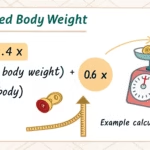Tricep Tendonitis Treatment – The triceps, key muscles in the back of our arms, play a central role in the strength and mobility of our upper limbs. When faced with pain in this area, it is crucial to identify the underlying causes and take appropriate action.
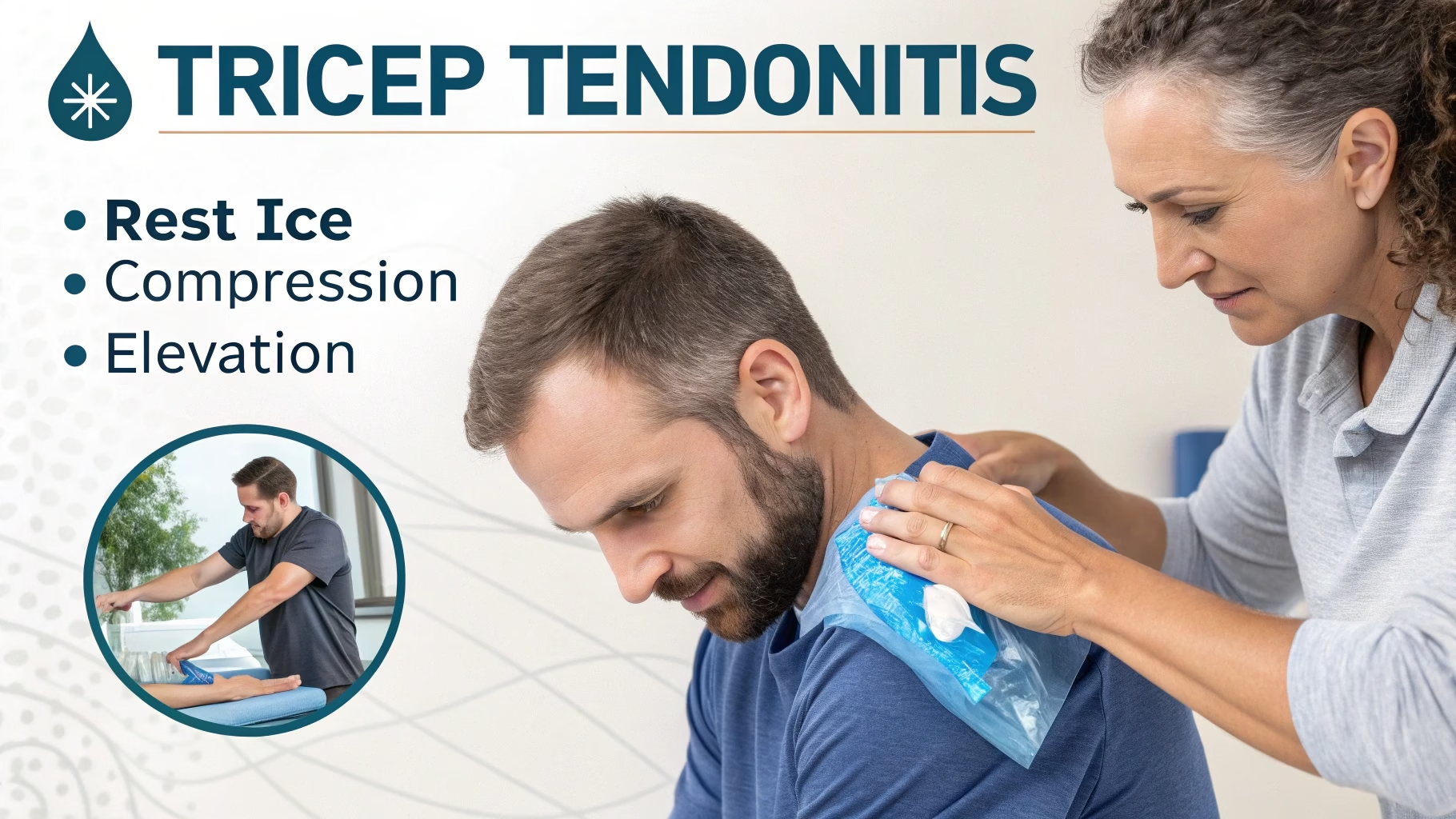
Whether it is tendinitis, a partial or complete tendon rupture, or any other condition affecting the long head, medial head, lateral head, or musculotendinous junction of the triceps, these conditions can seriously impair our ability to move without pain.
This guide aims to provide a comprehensive understanding of triceps pain, from its origins to the available treatment options, whether it involves weight training, sports, or daily activities.
Triceps pain can be localized, ranging from the lateral region of the shoulder blade to the posterior aspect of the humeral shaft, and can occur as a result of repetitive work, muscle injury, or even be a symptom of a more complex condition such as osteoarthritis.
For the suffering patient, a complete clinical examination, sometimes accompanied by injections, the use of massage balls, or shock waves, is a fundamental step toward recovery. Treatment can vary, ranging from rehabilitation to surgery, depending on the severity of the injury and the level of joint or tendon damage.
Understanding the complex anatomy of the triceps, located in the upper arm and inserting onto the upper end of the ulna at the elbow, as well as its function in arm extension and elbow flexion, is essential.
This includes a thorough understanding of the long head that inserts on the scapula, the lateral and medial heads that attach to the infraglenoid tubercle, and how these structures interact with the rest of the upper limb musculature, including the biceps brachii and coracobrachialis.
This guide is designed not only for those seeking to regain an active life without being hampered by triceps pain, but also for those interested in prevention. With a focus on accurate diagnosis, tailored treatments, and advice on incorporating strengthening and care practices into daily routines, we aim to empower each individual to effectively manage their triceps pain and prevent potential complications.
Tricep Tendonitis Treatment: What is triceps pain and why does it occur?
If you feel discomfort or pain in the back of your arm, below your shoulder, your triceps brachii muscle may be the cause. There are several reasons why this may occur.
Some are harmless and disappear within a few days, while others are more troublesome.
It can be caused by micro-tears in the muscle: physical exercise can cause small tears in the muscle fibers. This is a normal process which, when repaired, contributes to muscle growth.
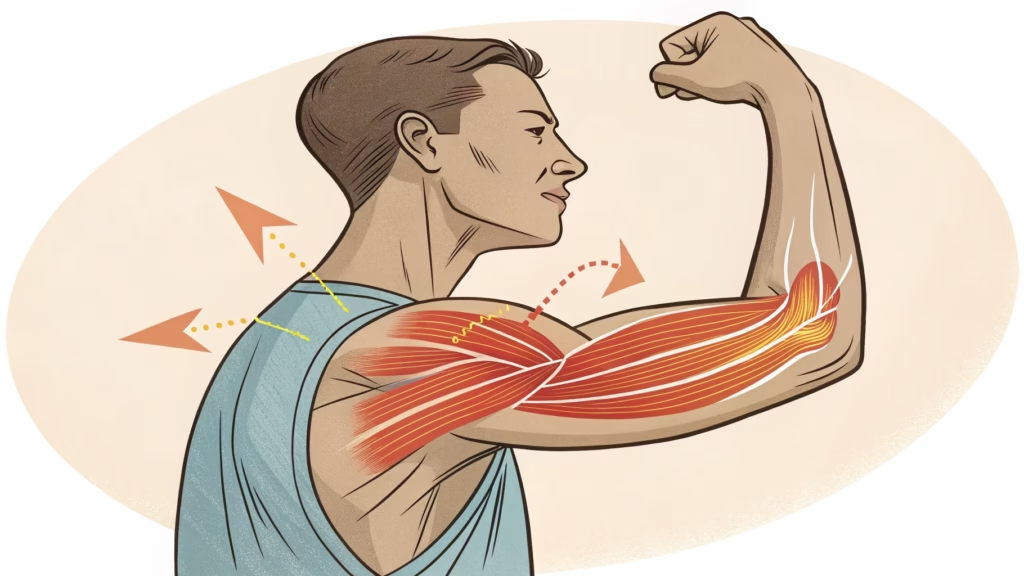
Inflammation: these same micro-tears cause an inflammatory reaction. The body sends immune cells to the site of the injury to begin the repair process, which can cause swelling, redness, and pain.
Muscle fatigue: Exercise depletes the muscle’s energy reserves, particularly glycogen, which can reduce the muscle’s ability to contract until it is properly rested and replenished.
Or tension on the tendons: muscles are attached to bones by tendons. Excessive or incorrect exercise can put excessive strain on these tendons, causing inflammation or pain, known as tendonitis!
Tricep Tendonitis Treatment: What are the common causes of triceps pain?
If you’re wondering how on earth you ended up in this situation, feel free to investigate our list of suggestions. You should find some clues…
Could it be muscle strain? Intense training or a sudden increase in activity can cause micro-tears in muscle fibers, leading to pain.
Or poor technique? Incorrect technique during exercises, especially those targeting the triceps, can put inappropriate pressure on the muscle and joints, causing pain.
Tendinitis? Inflammation of the triceps tendon, often due to repetitive movements or overload, can cause persistent pain in the back of the arm.
Or muscle tears? More serious injuries, such as partial or complete tears of the triceps muscle, are accompanied by pain, swelling, and loss of function.
Or insufficient rest and recovery? Lack of adequate rest and recovery between workouts can prevent micro-tears in the muscle from healing, leading to accumulated pain.
Tricep Tendonitis Treatment: Identifying your triceps pain
Triceps pain can have many causes and, above all, may not indicate the same problems. We can help you identify pain that could indicate the presence of more serious injuries.
How can you distinguish between triceps pain at rest and pain after exercise?
Triceps pain immediately after exercise is fairly easy to identify. It is usually related to muscle fatigue, overexertion, or micro-injuries caused by exercise. It appears a few hours to a day after physical activity and improves with rest.
Triceps pain at rest occurs without prior physical activity. It may indicate tendonitis or an injury requiring medical evaluation. This pain may be constant and intensify with certain arm movements or when pressure is applied to the muscle.
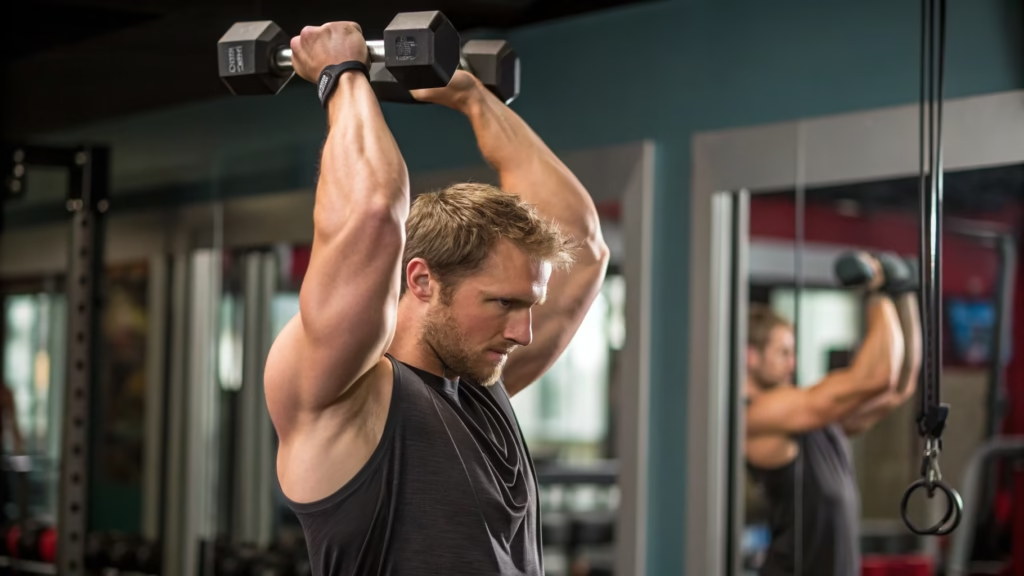
What are the signs of triceps tendonitis?
The following are clear signs of triceps tendonitis:
-Pain in the back of the arm: particularly near the junction where the triceps tendon attaches to the elbow bone. This pain may intensify during movement or after activities that strain the triceps.
-Sensitivity to touch: the area around the tendon insertion at the elbow may become particularly sensitive to pressure.
-Swelling or redness: this is not always the case, but sometimes inflammation can cause slight swelling or redness near the elbow.
-Weakness and difficulty fully extending the arm: loss of strength in the triceps or difficulty performing movements where the arm is fully extended are indicators of tendonitis.
Tricep Tendonitis Treatment: When does triceps pain require medical attention?
We don’t always listen to our bodies. Athletes, in particular, may tend to ignore certain pains so as not to compromise their training. It’s clear that this attitude is not the best one to take. If there is pain, it must be identified and, above all, it is important to understand when it requires medical attention.
When should you seek medical advice for persistent triceps pain?
If triceps pain persists beyond a few days of rest and taking anti-inflammatory medication, you should consult your doctor.
This is especially true if the pain prevents you from carrying out your daily activities by limiting your movements, for example, or causing a loss of strength.
You should also see a doctor if the pain gradually worsens or if it reappears regularly after training sessions, as this may indicate an underlying injury that requires specific treatment.
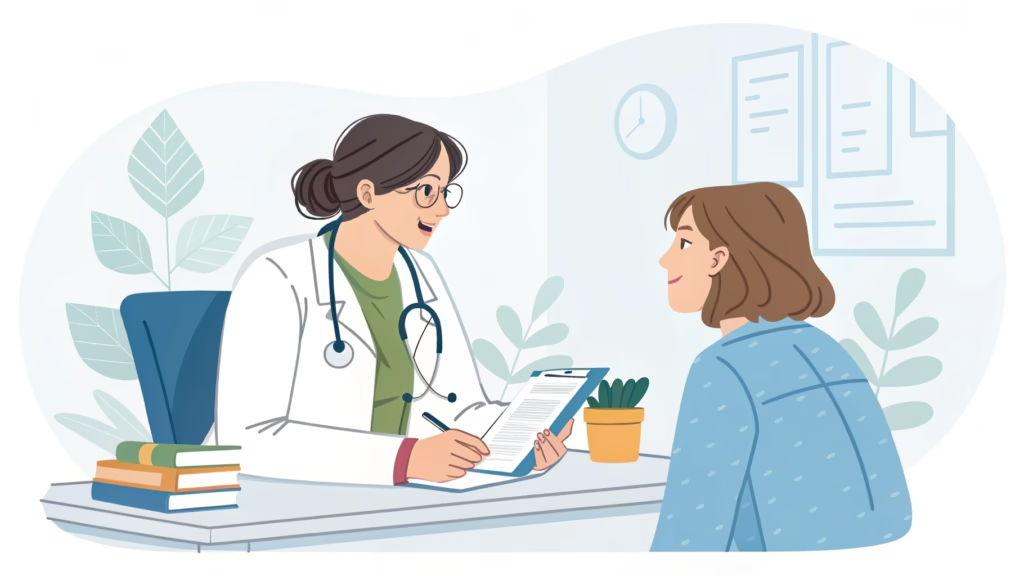
What symptoms of triceps pain should not be ignored?
Some symptoms should not be ignored more than others. Here is a short list to consult if necessary:
-Sharp or sudden pain: may be a muscle tear.
-Significant swelling, redness, or heat: could be inflammation or infection.
-Visible deformity: could be a torn muscle or tendon.
-Inability to use the arm: too debilitating to be ignored.
-Pain that disrupts sleep: too intense to be taken lightly.
Tricep Tendonitis Treatment: Treatment and relief of triceps pain
Don’t just put up with the pain—take action to ensure that, whether the problem is minor or more serious, you get relief as quickly as possible.
What approaches can be used to relieve triceps pain at home?
If you experience pain in your triceps, there are steps you can take yourself to relieve it.
Get plenty of rest and avoid activities that strain your triceps for a few days to allow your muscles to recover.
You can apply ice to the painful area. Fifteen to twenty minutes several times a day should help reduce inflammation and pain.
You can also use a compression bandage to minimize swelling and, if possible, keep your arm elevated.
After a few days of rest, you can also do some light stretching.
Triceps tendonitis: how long does it take to heal and how can you speed up the process?
The healing time for triceps tendonitis varies from a few weeks to several months. This difference can be explained by the severity of the inflammation and the patient’s compliance with treatment recommendations.
To speed up the healing process, it’s no surprise that you should follow your doctor or therapist’s advice, especially when it comes to rest and physical activity. Don’t rush back to the gym to do a set of front raises!
Rehabilitation exercises prescribed by a physical therapist strengthen the triceps muscle and improve tendon flexibility.
After the first few days, applying heat can promote blood circulation and healing. However, the inflammation must have subsided first.
Of course, you should adapt your training to avoid movements that exacerbate the pain and focus on low-impact exercises.
Pay attention to what you eat, as good nutrition and adequate hydration also contribute to tissue repair.
Medications such as ibuprofen can relieve pain and inflammation, but they should always be used with caution and according to the recommendations of a healthcare professional.
Tricep Tendonitis Treatment: Preventing triceps pain
Here, we’ll repeat the old adage: prevention is better than cure! Be sure to read and take on board these few common-sense tips that could help you avoid the worst!
How can you prevent triceps pain, especially after exercise?
As always, for all sports and every time you work out: warm up!
Start each workout with a warm-up that includes light cardio exercises and dynamic stretches to prepare your muscles and joints for exercise.
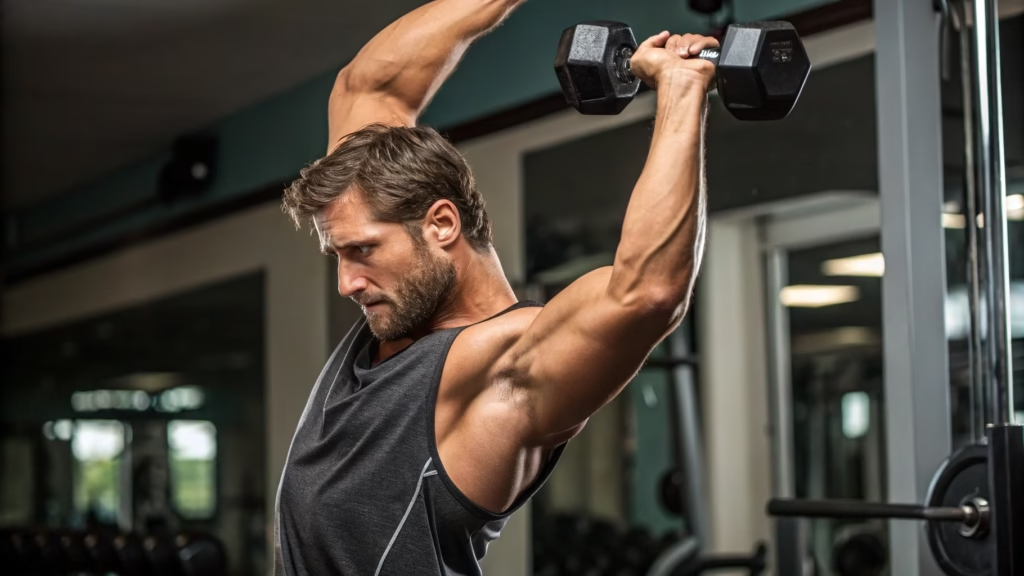
Avoid suddenly increasing the intensity or volume of your workout. Gradually increase the load and complexity of the exercises to allow your body to adapt.
Be uncompromising with your technique for all exercises. You can also work with a personal trainer to adjust your form and reduce the risk of injury.
Especially after exercise, incorporate rest days into your training routine to allow your muscles to recover and regenerate.
You can stretch the day after your workout to improve flexibility, reduce muscle tension, promote recovery, and prevent soreness.
These stretches should be done gently, without causing pain, and held for 15 to 30 seconds to be effective.
What stretching routines can help prevent triceps pain?
For your triceps stretches, we recommend these exercises:
Standing or seated triceps stretch: Raise one arm above your head, bend your elbow to bring your hand toward the middle of your back, and use your other hand to gently push your elbow backward. Hold for 20 to 30 seconds, then switch arms.
Triceps stretch with a towel: Hold a towel in one hand and let it hang behind your back. Grasp the other end of the towel with your opposite hand from below and gently pull to stretch your triceps. Hold and repeat on the other side.
Doorway triceps stretch: Place your elbow and forearm on a door frame, with your elbow at shoulder height. Step forward with the foot opposite the stretched arm and lean forward slightly to intensify the stretch. Hold, then switch sides.
Tricep Tendonitis Treatment: Managing triceps pain in different situations
Your triceps pain can occur in different situations. It is useful to analyze certain signs in order to best manage the discomfort caused by the pain and, above all, to prevent it from recurring.
What should you do if you experience triceps pain when raising your arm or at rest?
Unsurprisingly, if you experience triceps pain when raising your arm or at rest, limit the use of your arm as much as possible.
Apply ice wrapped in a cloth to the painful area for 15-20 minutes, several times a day, to reduce inflammation and pain.
If the pain persists despite these measures, intensifies, or significantly limits your mobility, consult a healthcare professional for an evaluation and appropriate treatment.
Specific approaches for left triceps pain: unique considerations
For pain specific to the left triceps, the approach should not differ from that for the right triceps, as the treatment and rehabilitation measures are similar. However, you should pay attention to certain points:
Try to understand how your daily activities or posture might specifically strain or put tension on the left triceps.
Differences in biomechanics or muscle imbalances between the right and left sides of the body should be given special attention during rehabilitation. A healthcare professional can perform a personalized assessment to determine if there are specific factors contributing to left triceps pain.
Rehabilitation and strengthening of the triceps
What rehabilitation exercises are recommended for painful triceps?
It is entirely possible to resume exercise with a sore triceps. Rehabilitate the area slowly, starting with low-intensity exercises:
Wall triceps extensions: Stand facing a wall, extend your arms to push your hands against the wall, gently engaging your triceps.
Low-resistance pulley presses: use a pulley machine with very light resistance to perform triceps extensions, making sure to maintain proper technique.
Triceps stretches: raise one arm above your head, bend your elbow to bring your hand toward your back, and use your other hand to gently push your elbow, stretching your triceps.
These exercises should be performed while paying attention to any pain and avoiding any movements that cause discomfort.
How can you strengthen your triceps to prevent future pain?
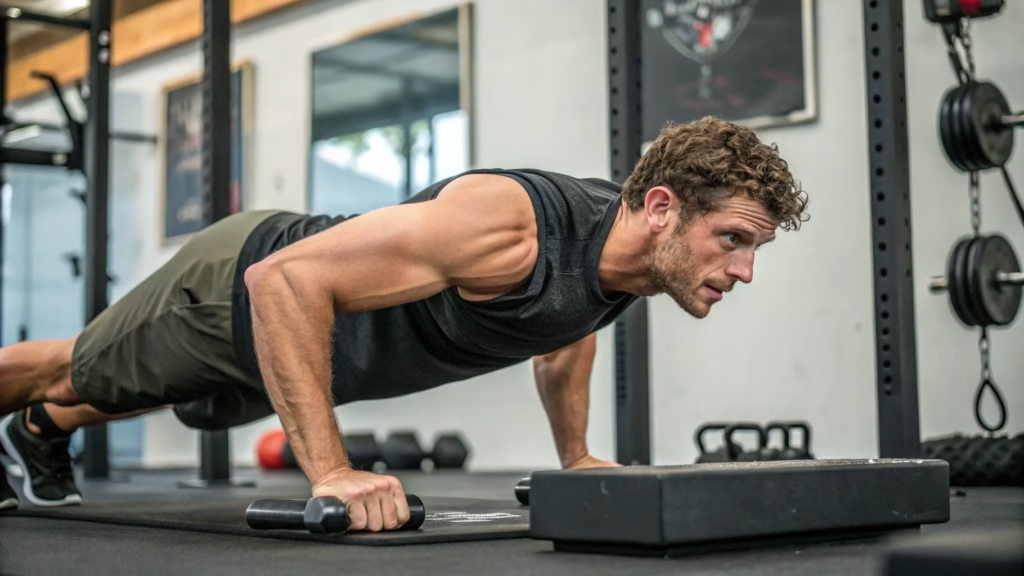
Before disaster strikes, you can also strengthen your triceps and prevent pain.
Certain exercises, such as bench dips, are a good way to gently build muscle. You can start by keeping your feet on the ground to reduce the load.
Triceps extensions with dumbbells or an EZ bar, always choosing light weights, allow you to focus on technique and muscle contraction and also strengthen your triceps.
Finally, kickbacks with dumbbells, making sure to keep your movement controlled and your back straight, are also very good for your muscles.
Gradual progression in terms of weight and training volume is essential to allow the triceps to strengthen without the risk of overexertion. This is something we absolutely want to avoid!
Why hire a personal trainer for your next workout sessions?
There is another way to avoid injuries and overexertion during your training. Hiring a personal trainer for your next workout sessions has several advantages:
A trainer will design a customized training program tailored to your goals and current fitness level, taking into account any pain or injuries you may have.
A coach helps you improve your technique, which is crucial for preventing injuries and maximizing the effectiveness of each exercise.
Working with a coach increases your motivation and encourages you to stay committed to your training program. They provide you with professional advice.
The support of a personal trainer is particularly beneficial for those looking to overcome muscle pain, improve their performance, or simply work on their physical well-being in a safe and effective way.
Tricep Tendonitis Treatment : FAQ
How can I treat triceps pain?
To treat triceps pain, rest the affected muscle, apply ice to reduce inflammation, and consider taking nonsteroidal anti-inflammatory drugs. If the pain persists, consult a healthcare professional.
How can I relieve triceps pain?
Relieve triceps pain by applying ice, doing gentle stretches, and performing low-intensity exercises to promote circulation. Rest and adequate hydration are also important.
How can I relieve triceps soreness?
To relieve soreness in the triceps, do light stretching, use heat (such as a hot compress), stay hydrated, and consider a gentle massage to improve blood circulation.
How to massage the triceps?
Massage the triceps using your fingers or a massage roller to apply moderate pressure along the muscle, using slow, steady movements to relax the muscle tissue and improve circulation.
How do you know if you have biceps tendonitis?
Biceps tendonitis can manifest as pain in the front of the arm, near the shoulder or elbow, which intensifies with movement or pressure, sometimes accompanied by swelling or tenderness.
Why does my right arm hurt?
Pain in the right arm can result from a variety of causes, such as muscle tension, tendonitis, injury, or more complex conditions such as nerve or circulatory problems. A medical consultation is recommended for an accurate diagnosis.



